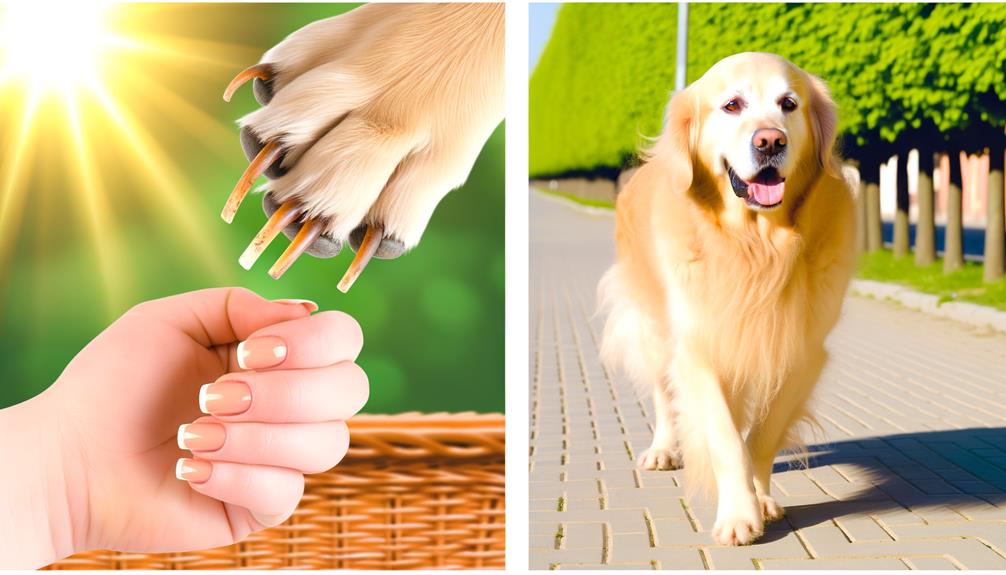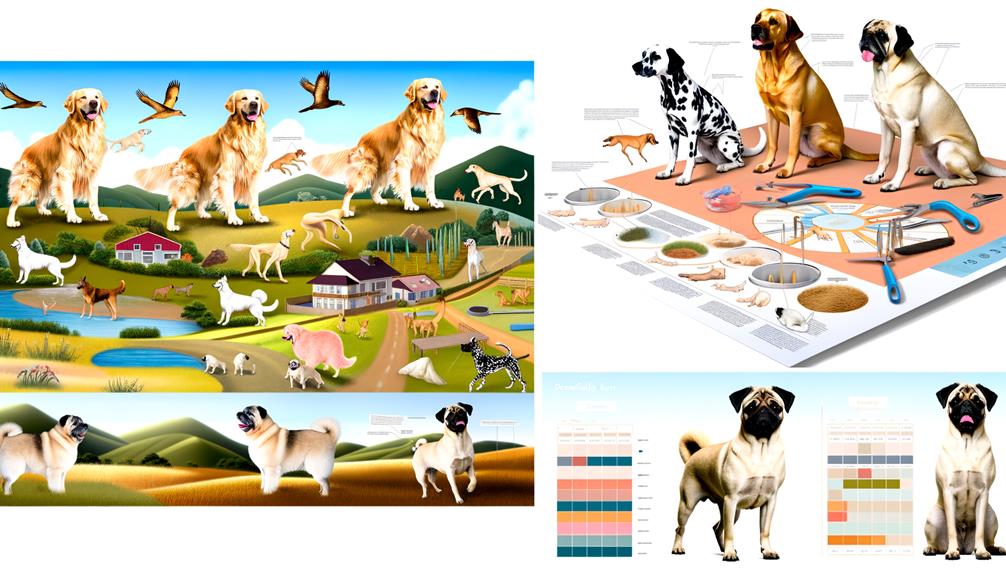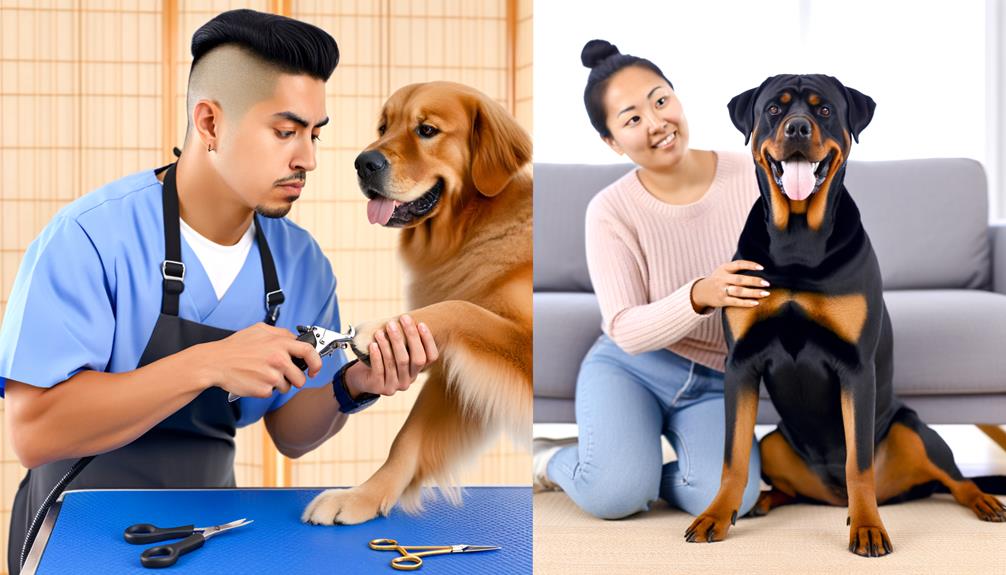As a pet owner, you know your dog’s health is paramount, and that includes regular nail trims. But how often should this task be undertaken? The answer isn’t as straightforward as you might think. It depends on your dog’s lifestyle, breed, and individual nail growth rate. So, let’s take a moment to explore the factors influencing nail growth and the consequences of neglecting this crucial part of your dog’s grooming routine. You might find the insights surprising.
Understanding the Importance of Nail Trimming

You mightn’t realize it, but regular nail trimming is crucial for your dog’s health and comfort. Long nails can cause a lot of discomfort and even lead to painful nail disorders. Overgrown nails can curve into the pad of the dog’s paw, causing severe pain and infection. Even walking can become a painful chore for your pooch, affecting their overall quality of life.
Trimming your dog’s nails can also help reduce grooming anxiety. If you’ve ever tried to trim a dog’s nails, you know it’s not always a walk in the park. Dogs often associate nail trimming with discomfort, especially if their nails have been cut too short in the past. However, by making nail trimming a regular part of your dog’s grooming routine, you can help alleviate this anxiety. They’ll slowly become accustomed to the process, making it less stressful for both of you.
Don’t overlook the importance of regular nail trimming. It’s not just about keeping your dog’s paws looking neat; it’s about ensuring their health and happiness. So, grab those clippers and make nail trimming a priority.
Factors Influencing Nail Growth

You might wonder, what factors influence the growth of your dog’s nails?
It’s not a one-size-fits-all answer, as breed, age, and nutrition all play a part.
Let’s explore these elements to better understand the rhythm of your pup’s nail growth.
Dog Breed and Nails
Surprisingly, a dog’s breed can significantly influence the rate of their nail growth. Some breeds have quicker growing nails, requiring more frequent trims. This is where breed specific grooming comes into play.
For instance, larger breeds tend to have thicker, faster-growing nails. On the other hand, smaller breeds may have thinner nails that grow at a slower pace. Nail color variations also factor into the equation. Darker nails generally grow faster than lighter ones, so if your pup has darker nails, you might need to grab the clippers more often.
It’s crucial to understand these variations to maintain your dog’s paw health. So, always keep an eye on your dog’s nails and adjust your grooming routine accordingly.
Age-Related Nail Growth
Just as with humans, a dog’s age can significantly impact the rate of their nail growth. Older dogs typically experience slower nail growth compared to their younger counterparts. Age-related nail growth is determined by several factors:
- Physical activity: Less active dogs have slower nail growth.
- Health conditions: Certain ailments can affect nail growth.
- Paw discomfort signs: Limping or paw licking can indicate overgrown nails.
- Nail health indicators: Discoloration or splitting nails hint at health issues.
Understanding these factors helps you monitor your dog’s nail health, preventing discomfort or potential health issues.
In the end, maintaining the right nail length contributes to your dog’s overall well-being. Therefore, it’s essential to regularly check for these signs and trim your dog’s nails appropriately.
Nutrition’s Role in Growth
In addition to age and physical activity, your dog’s diet plays a significant role in their nail growth. The dietary impact can’t be overstated. A balanced, nutrient-rich diet can promote healthier and faster nail growth. It’s not just about quantity, but quality too. The right balance of proteins, fats, and vitamins are crucial.
If you’re noticing slow growth or brittle nails, it might be time to reassess your pet’s diet. Speak to your vet about potential dietary changes or growth supplements that could help. These supplements often contain essential nutrients like biotin, omega-3 fatty acids, and other vitamins which specifically aid nail growth. Remember, proper nutrition doesn’t just impact your dog’s overall health, but also the condition of their nails.
Recognizing Overgrown Nails

Knowing when your dog’s nails are overgrown is crucial for their comfort and health. Unusual growth patterns can be a red flag. You don’t want to ignore this aspect of pet care, as it can lead to pain, injury, and various health issues. Learning to recognize the signs of overgrown nails can ensure your dog stays happy and healthy.
Firstly, pay attention to nail health indicators. If your dog’s nails:
- Are touching the ground when they stand still,
- Cause discomfort when they walk,
- Get caught in carpets, rugs, or fabrics,
- Look visibly longer or curved,
Then the nails are likely overgrown. These signs might be subtle at first, but they’ll become more apparent as the nails grow. It’s your responsibility to keep an eye on these tell-tale signals.
The key to good pet health often lies in the details. By recognizing signs of overgrown nails early on, you’ll be in a better position to maintain your dog’s nail health. In the upcoming section, we’ll discuss ‘Nail Trimming Frequency Guidelines’ to help you keep your dog’s nails in check.
Nail Trimming Frequency Guidelines

Now let’s talk about nail trimming frequency guidelines for your dog.
First, you’ll need to understand your dog’s nail growth patterns.
Then, we’ll cover the importance of regular trimming and how to determine the best trim schedule for your pet.
Understanding Dog Nail Growth
To keep your dog’s nails in tip-top shape, it’s crucial to understand their growth patterns and how often they should be trimmed. Just like humans, dogs face nail diseases and disorders which can affect how their nails grow. Here’s what you need to know:
- Dogs’ nails grow continuously, just like ours. However, their growth rate can be influenced by their age, breed, and overall health.
- Regular walks on concrete or asphalt can naturally wear down your dog’s nails, reducing the need for frequent trims.
- Nail disorders can cause your dog’s nails to overgrow or become brittle. This makes regular trimming and inspection critical.
- Nail diseases, such as fungal infections, can cause irregular nail growth and discomfort for your dog.
Understanding these factors will help you determine the right nail trimming frequency for your dog.
Importance of Regular Trimming
Regular nail trimming isn’t just about keeping your pup’s paws looking neat; it’s also crucial for their health and comfort. Overgrown nails can curve into the paw pad causing pain and discomfort, and that’s where Pain Prevention comes in. By maintaining a regular trimming schedule, you’re helping to prevent potential pain from overgrowth and infection.
Another key reason for regular trimming is Mobility Improvement. Long nails can alter your dog’s stance and movement, leading to orthopedic issues over time. By keeping the nails short, you’re ensuring your pup can walk, run, and play comfortably.
Determining Trim Schedule
Understanding how often to trim your dog’s nails can be a bit tricky, as it largely depends on your pooch’s lifestyle and breed characteristics. You can create a trim schedule by considering several factors:
- Activity Level: Active dogs that often walk on hard surfaces may wear down their nails naturally.
- Breed: Certain breeds have faster-growing nails.
- Trim Tools: Proper tools can make the process easier, influencing the frequency.
- Owner Anxiety: If you’re nervous about trimming your dog’s nails, you might do it less often.
Professional Vs. Home Nail Trimming

While you may feel comfortable trimming your dog’s nails at home, it’s worth considering the benefits of professional grooming services. Professionals not only have access to high-quality trimming equipment, but they also have the expertise necessary to handle the job efficiently and safely. This can be particularly important if your dog is prone to anxiety or stress during grooming sessions, as professionals are trained in anxiety management techniques that can help keep your pet calm.
On the other hand, doing it yourself at home can save you money and can also be a bonding experience for you and your pet. It gives you control over the process, allowing you to trim at a pace that’s comfortable for both you and your dog. However, you’ll need to invest in good quality trimming equipment and learn how to use it properly to avoid injuring your pet.
Tips for Safe and Effective Trimming
Whether you choose to use a professional service or trim your dog’s nails at home, it’s important to know some key tips to ensure the process is both safe and effective for your pet.
Firstly, choosing the right trimming tools is crucial. You’ll find a variety of options available, including dog nail clippers, grinders, and scissors. Each has its pros and cons, so you’ll need to find what works best for you and your pet.
To make the nail trimming process smoother, consider these tips:
- Do some preparation: Familiarize your dog with the trimming tools before you start. Let them sniff and touch the tools to reduce their anxiety.
- Keep it short and sweet: Don’t try to trim all your dog’s nails at once, especially if they’re anxious. Spread it out over a few days.
- Reward your pup: Treats, praises, and playtime after trimming can help reduce anxiety and create positive associations.
- Stay calm and patient: Your dog can pick up on your mood. If you’re tense, they’ll be tense too.
Frequently Asked Questions
What Tools Can I Use to Trim My Dogs Nails?
For trimming your dog’s nails, you can use a guillotine nail clipper or grinder. It’s crucial to maintain your tools properly for safety. Learn nail trimming techniques to prevent injuring your pooch.
How Can I Calm My Dog During the Nail Trimming Process?
You can calm your dog during nail trimming using dog sedation methods, like calming chews or sprays. Also, use stress reducing techniques, such as gentle stroking, soothing sounds, or even a favorite toy.
What Should I Do if I Accidentally Cut Into the Quick of My Dogs Nail?
If you’ve cut into the quick, don’t panic. Apply styptic powder for quick recovery and stop the bleeding. Monitor your dog’s behavior to manage any pain. If it continues, contact your vet immediately.
Are There Any Specific Breeds That Require More Frequent Nail Trims?
Certain breed’s grooming needs do include more frequent nail trims. It’s not a rule, but active breeds tend to wear their nails down naturally. Understanding breed-specific grooming can highlight the benefits of frequent trims.
Can I Use Human Nail Clippers to Trim My Dogs Nails?
You shouldn’t use human clippers for your dog’s nails. The risks include splintering the nail and causing pain. Incorrect tools can have serious health implications for your pet. Always use trimmers designed for dogs.
Conclusion
So, remember, your dog’s nail trimming schedule depends on several factors. Regularly monitor their nails and adjust the frequency as necessary.
Generally, every 2-4 weeks is a good guideline, but your pup may need more frequent trims. Whether you opt for professional services or do it at home, safety and comfort are key.
Nail care is an integral part of your dog’s overall health, so don’t overlook this vital grooming task.







